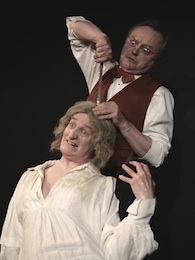Gerard Lee’s Mangan’s Last Gasp, set in the final days of poet James Clarence Mangan, offers a glancing retrospective of a troubled life by making heavy use of both the poetry and autobiographical works. The play centres on the documented role that medic William Wilde played in this endgame. The man of science as prompt, foil and interlocutor works well as a device; what could have been yet another one-man narrative of a writer becomes something far more dynamic. The resultant counterpoint suggests that the sensibility gap between the arts and sciences may have been just as great in the Victorian era as it is today, despite recent theories to the contrary.
Lee writes and portrays a Mangan whose brilliant, ranging mind is ravished by excess, his thought processes beyond the scope of the rational scientific method which is Wilde’s sole frame of reference. An underdeveloped thread of Mangan’s blighted love affair with Margaret Stacpole, which may have triggered his decline, leaves us wanting more. Reference to the writer's prodigious output under a selection box of nom de plumes, evidences his fevered drive to create from a core of pained experience.
 There is great chemistry and timing between Lee and Michael James Ford as Wilde, much of it ghoulishly comic. Lee, in cadaverous stage makeup and fright wig (the work of Patricia McDevitt), delivers his lines as though from beyond the grave – or at least teetering on its edge. Ford’s toothy bonhomie never falters. A third presence, the immensely genial Pierpaolo Vitale, composed the score which he sings and plays on an upright piano with exposed sounding board. The effect is akin to the bordello or saloon pianist who partakes of the degeneracy around him. Working within the limitations of Bewley’s small stage, director Iseult Golden opts to have Vitale perform with his back to the audience – a profile silhouette might have added a dimension without detracting from the essential focus on the ongoing dialogue.
There is great chemistry and timing between Lee and Michael James Ford as Wilde, much of it ghoulishly comic. Lee, in cadaverous stage makeup and fright wig (the work of Patricia McDevitt), delivers his lines as though from beyond the grave – or at least teetering on its edge. Ford’s toothy bonhomie never falters. A third presence, the immensely genial Pierpaolo Vitale, composed the score which he sings and plays on an upright piano with exposed sounding board. The effect is akin to the bordello or saloon pianist who partakes of the degeneracy around him. Working within the limitations of Bewley’s small stage, director Iseult Golden opts to have Vitale perform with his back to the audience – a profile silhouette might have added a dimension without detracting from the essential focus on the ongoing dialogue.
Andrew Murray and Jack Kirwan’s set confronts the arriving audience in all the deliciously rendered squalor of Mangan’s lodging, including what looks a mass of dirty linen in a bed. This heap reveals itself to be Lee as Mangan in supposed corpse mode, and who eventually emerges wearing yet more dirty linen. When he finally dons the iconic age-worn cape and conical hat hanging on a peg, he becomes the mythic Dublin figure he was in his day, one who was more than once reported dead. Mangan’s ongoing artistic engagement with death seems of a piece with his surroundings. Eerily lit throughout (lighting by Colm Maher), in part by candlelight, the claustrophobic scene can only augur his doom.
It’s difficult to expect contemporary audiences to listen to nineteenth-century poetry on stage, no matter how rare the quality and expert the delivery (and Lee is a fine speaker of verse). Mangan, so familiar to the Dubliners of his era, has (unlike Yeats, Joyce, O’Casey and even Swift), faded from the Irish collective consciousness. Lee’s short play does much to restore the man, although the poetry remains more difficult to access in a stage production.
Christina Hunt Mahony, who directed the Center for Irish Studies at the Catholic University of America, now lectures in Trinity College. She is the editor of Out of History: Essays on the Writings of Sebastian Barry.